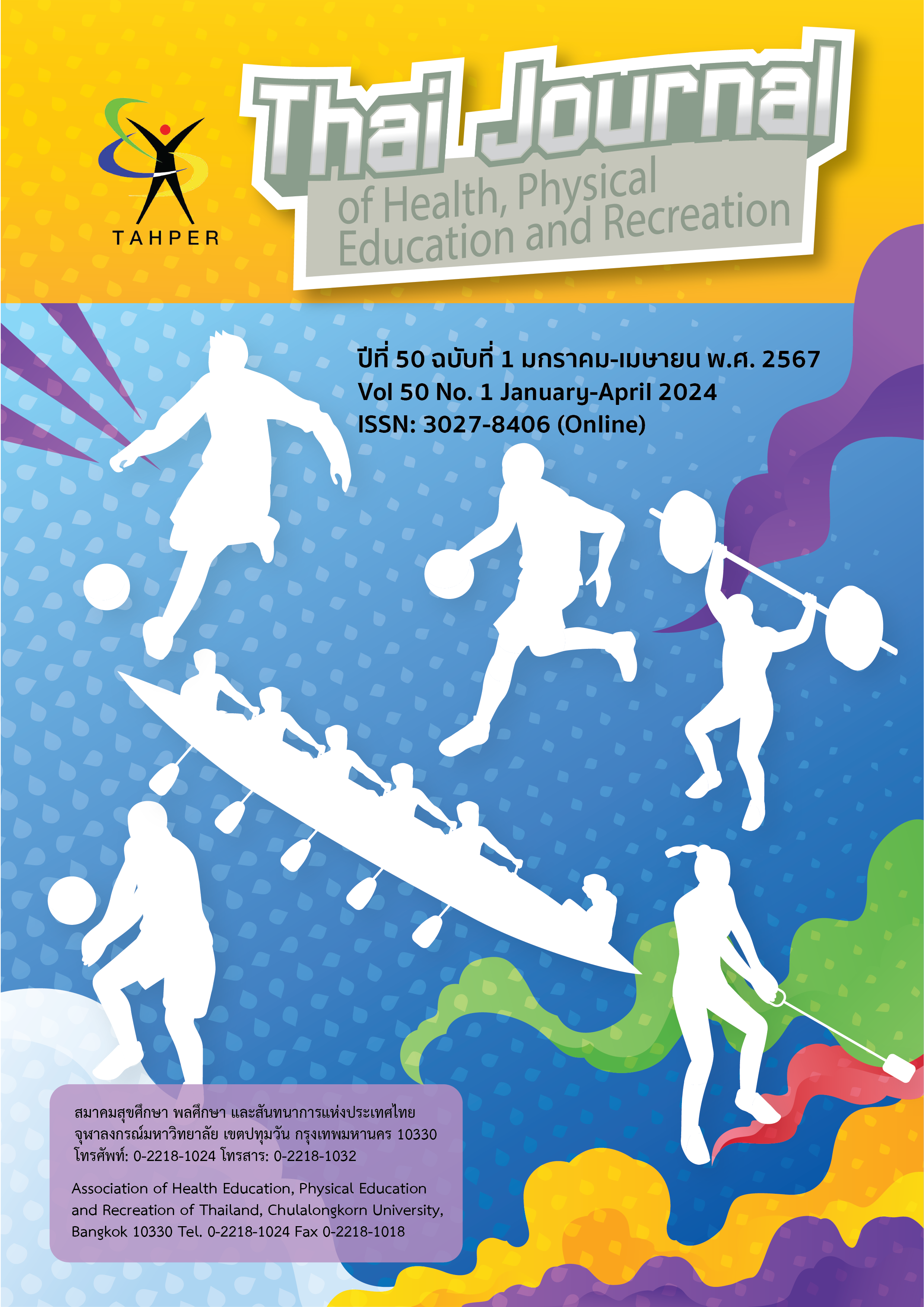The Analysis of Angle and The Simulation of Joint Dynamic of Sprint in Youth Athletes of National Thailand Team
Main Article Content
Abstract
The purposes of this research were to analyze angle in the sprint start of 100 meters dash and to simulate the dynamic of knee joint, the angle of body, angle of head and angle of foot of the youth athletes in sport schools of Thailand national sports university. 6 male athletes Thailand youth team were purposively selected as the sample group. Research instruments were still image and motion camera and angle test application. Video recording to gather data on starting block position of 6 athletes in 100 meters dash. 2 dimensional motion analysis by using Kinovea application to measure feet angle, knee angle, body angle, head angle, acceleration and speed of 100 meters dash. Statistical analysis were mean, Index of Qualitative Variation (IQV), force analysis both vertical and horizontal level in accordance with mechanics force analysis. The results were as follows: 1.The average degree as the athlete was in “Set Position” were as follows, The leading knee angle was 93.89 degree, The back knee angle was 127.17 degree, The body angle was 196.89 degree, The head angle was 42.67 degree. 2. The body angle as the athlete was in “GO” position was 49.11 degree. 3. The average degree of body angle as the athlete run for the first 10 meters, was 65.50 degree. 4.The average degree of body angle as the athlete run for the first 30 meters, was 74.00 degree. 5.The average speed for 100 meters was 10.92 seconds. 6. The average acceleration for 100 meters was 0.839 m/s2 7. While running the angle of the follow step of back foot should not more than 60 degree and the angle of leading step was around 60 degree.
Article Details

This work is licensed under a Creative Commons Attribution-NonCommercial-NoDerivatives 4.0 International License.
Critical thinking in journals is the right of the author. The Association of Health Education, Physical Education and Recreation of Thailand is not always required, to create diversity in ideas and creativity.
ความคิด ข้อวิพากษ์ในวารสารเป้นสิทธิของผู้เขียน สมาคมสุขศึกษา พลศึกษา และสันทนาการแห่งประเทศไทยไม่จำเป็นต้องเห็นชอบด้วยเสมอไป เพื่อให้เกิดความหลากหลายในความคิดและความสร้างสรรค์
References
ถาวร กมุทศรี. (2551). การศึกษาทางชีวกลศาสตร์ของการออกตัวและอัตราเร็ววิ่ง 100 เมตร ของนักวิ่งระยะสั้นทีมชาติไทย. กรุงเทพฯ : การกีฬาแห่งประเทศไทย.
วิสุทธิ์ วัฒนสิน. (2534). การวิเคราะห์ลักษณะการวิ่งระยะสั้น ในช่วงความเร็วต้น. มหาวิทยาลัยศรีนครินทรวิโรฒ ประสานมิตร/กรุงเทพฯ.
Atwater, A. E. (1986). Movement: A kinematic analysis of men and wornen performance. dissertation Abstracts International. (31): 459-A.
Bezodis N. E., Willwacher S. and Salo A. I. T. (2019). The biomechanics of the track and field sprintstart: A Narrative Review. Sports Medicine, 49(9): 1345-1364.
Bissas A., Walker J., Tucker C. and Paradisis G. (2018). Biomechanics reports for the IAAF world championships London 2017. Leeds Beckett Universty Carnegie School of Sport. 70p.
Böttcher J. (2009). Measurement of step length and frequency in maximum sprint with Optojump, Zeitschrift für Angewandte Trainingswissenschaft, 16(2): 100-110.
Ecker T. (2014). Basic Track & Field Biomechanics (Fourth Edition) Taf news press. USA p.141.
Ferber R. and Macdonald S. (2014). Running mechanics and gait analysis. Human Kinetics; p70.
Girard O., Brocherie F., Morin J.B., Millet G.P. and Han C. (2020). Running mechanics and leg muscle activity patterns during early and late acceleration phases of repeated treadmill sprints in male recreational athletes. European Journal Applied Physiology, 120(12): 2785-2796.
Kim S., Park J. and Jingang H. (2023). comparison of muscle activity and muscle thickness according to knee flexion angle during supine bridge exercises using the abdominal drawing-in maneuver on an unstable surface. Journal of Sports Science and Medicine, 22(3): 431-435.
Mero A. (1988). Force-time characteristics and running velocity of male running the acceleration phase of sprinting. Research Quarterly for Exercise and Sport, 58(2): 94-98.
Morin J.B., Gimenez P. and Edouard P. (2015). Sprint acceleration mechanics: The major role of hamstrings in horizontal force production. Frontier Physiology, 6: 1-14.
Nagahara R. and Olivier G., (2020). Alterations of spatiotemporal and ground reaction force variables during decelerated sprinting. Scandinavian Journal of Medicine and Science in Sports, 31(3): 586-596.
Rabita G., Dorel S. and Slawinski J. (2015). Sprint mechanics in world-class athletes: a new insight into the limits of human locomotion. Scandinavian journal of medicine and Science in Sports, 25: 583-594.
Radtord P.F. (1990). Physiology of Sport. [Online] Available from: www.imd.inder.cu (28 April 2023).
Slawinski J., Termoz N., Rabita G., Guilhem G., Dorel S., Morin J.B. and Samozino P. (2017). How 100-m event analyses improve our understanding of world-class men's and women's sprint performance. Scandinavian journal of medicine and Science in Sports, 27: 45-54.


